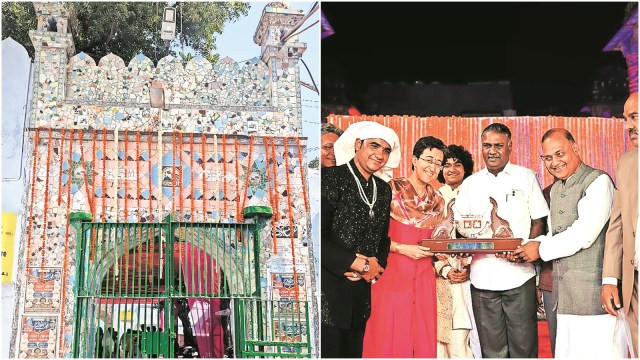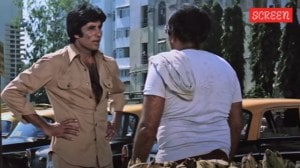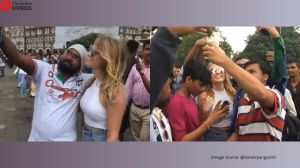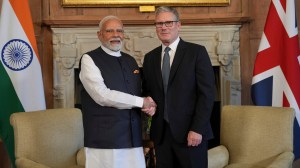A queen’s promise, a festival spanning 200 years: How Phoolwalon ki sair is a testament to Delhi’s syncretic culture
Speaking at the event, CM Atishi said, “'Phool Waalon Ki Sair’ is not just a festival; it has upheld the tradition of Delhi's centuries-old Ganga-Jamuni Tehzeeb.”
 The decked up dargah (Left); CM Atishi at Phoolwalon ki sair this year (Right). (Express Photos)
The decked up dargah (Left); CM Atishi at Phoolwalon ki sair this year (Right). (Express Photos)In the early 19th Century, around the time the Mughal empire began to fade, a rebellious prince began to turn into a thorn in the side of the British. All of 19, Mirza Jahangir fired at the then British resident and was exiled to Allahabad. His mother, Mumtaz Mahal Begum, made a vow: Once her son returned, she would walk barefoot from the Red Fort to Qutubuddin Bakhtiyar Kaki dargah in Mehrauli to offer her gratitude.
Her prayers were answered, and the queen decided to keep her promise. To ease her journey, it is said, the local people scattered flowers throughout her route. The flower seller also made floral pankhas (fans) offered to the Kaki dargah and the nearby Yogmaya temple. So popular was the event that it was decided to be held yearly. The result was a week-long annual celebration called the Phoolwalon ki sair or Sair-e-Gulfaroshan.
Over 200 years on, the tradition continues and serves as a testament to Delhi’s syncretic culture.
This year, the event kicked off on October 21 and saw the organisers, Anjuman Sair-e-Gul Faroshan, presenting the ceremonial pankha, with a picture of Goddess Durga juxtaposed with an image of the Madina mosque, to Chief Minister Atishi.
Phoolwalon ki sair was instituted in 1811, writes author and historian Swapna Liddle in her book, 14 Heritage Walks of Delhi. “…it became an annual fair sponsored by the palace…”
In 1942, during the Quit India Movement, the British stopped the festival. “Prime Minister Jawaharlal Nehru restarted it in 1962…The president of India and the Lt Governor of Delhi are ceremoniously invited with the shehnai being played at their residence,” writes author and historian Rana Safvi in her book, Where Stones Speak – Historical Trails in Mehrauli, the First City of Delhi.
Pakistani journalist Raza Rumi wrote in his book, Delhi by Heart: “(Phoolwalon ki sair is) a multicultural event that involved Hindus, Muslims, mullahs and pandits all in one go.”
On Saturday night, Jahaz Mahal, a Lodhi-era structure in Mehrauli, was all decked up with lights and marigold flowers to host a cultural event to mark the celebrations. Cultural performances and a splendid Qawwali were part of the event, a press note by the Delhi government stated.
Speaking at the event, CM Atishi said, “Phool Waalon Ki Sair is not just a festival; it has upheld the tradition of Delhi’s centuries-old Ganga-Jamuni Tehzeeb.”
Asif Khan Dehlvi, founder of Delhi Karavan, said: “Given instances of strife around the world, the festival is more relevant than ever before. An occasion where people of all faiths and walks of life come together and celebrate, what can be more beautiful than that?”
As the last Mughal emperor Bahadur Shah Zafar said: “Waqai sair hai ye dekhne ke qaabil, Chasm e anjum ho na iss sair par kyun maai’l”. “To look at this ceremony is such a delight; Why wouldn’t the stars gaze at this very ceremony,” translates Safvi in her book.











